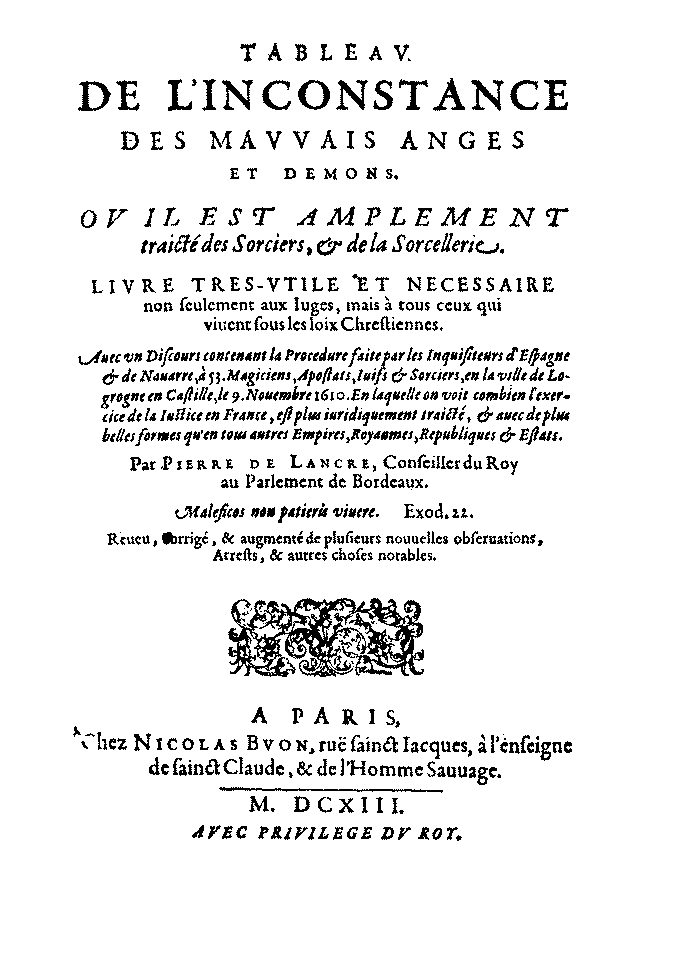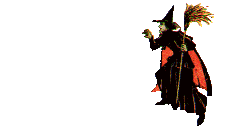Pierre de Lancre (c.1553-1630)

Second edition of Lancre's most famous work larger image

It is true that in 1609 Lancre and his colleague, Jean d'Espagnet, presided over one of the very few mass trials of witches in French history, in the Basque region of southwest France. However, the idea that his victims were in the hundreds seems highly unlikely, as this tenacious myth appears to spring from nothing more than a late seventeenth-century misreading of a passage in his prefatory remarks, being passed thence from one historian to another. All popular references to Lancre give a figure of 600 or 700 deaths.
[speaking of the flight to the sabbat, Lancre said, "Ie puis bien dire ce que soixante ou quatrevingts insignes Sorcieres, & cinq cens tesmoins marquez du charactere du Diable, (qui confirme merueilleusement leur deposition) nous ont dict que Satan leur a faict faire: mais par quels moyens, ie ne le puis dire ny descouurir puis que les Sorciers ne le sçauent eux-mesmes."]
The celebrated inquisitor who dealt so calmly with the Spanish side of the Basque witch panic, Alonso de Salazar, remarked that his French counterparts had burned over eighty people. In his book, Lancre mentions only forty-six actual witches and thirty-five witnesses, children and young people who had attended, more or less unwillingly, the witches' sabbat. A figure of somewhere between thirty and eighty executions is now generally accepted by scholars, although the larger figure is still being peddled by sensationalists. When Lancre wrote his book, he had access to the trial records but they burned in a fire in 1710. It is therefore impossible to go beyond the primary material quoted by Lancre in his book to check it against the depositions, but the inflated figures seem impossible to maintain. With their disappearance, a reassessment of Lancre himself is needed. The denunciation of Lancre by generations of historians has coloured understanding of French witchcraft prosecutions more generally, and muddied historical analysis. Moreover, the centrality of the stories he told, to both the Romantic historiography of Michelet, Margaret Murray or Montague Summers and to more sober historical analyses, makes his reputation crucial for an understanding of the relationship between prosecutions and popular accusations.
Pierre de Lancre was born in Bordeaux and educated at the College de Clermont in Paris, where he probably heard the lectures of the Spanish Jesuit, Juan de Maldonado, known in France as Jean Maldonat. This immensely popular lecturer took the line that faith, not reason, was the only means of understanding theology. A zealous anti-Protestant, in 1569-70 he took part in the Jesuit mission that followed the military campaign against the protestants of Lorraine. On his return to Paris, he gave a series of lectures that were later published by his pupil, François de la Borie, as Traicté des Anges et Demons. These lectures also underlay the demonological work published by another pupil, Martin Del Rio SJ. For Maldonat, the servants of the Devil included all opponents of Tridentine Catholicism: atheists, philosophers, Protestants, Jews, and witches. All the current demonological beliefs, including transportation to the sabbat and the murder of infants to create ointments, were not only orthodox but necessary for Catholics to believe. Only heretics would deny such doctrines.
Lancre received his doctorate of laws in 1579 and joined the Parlement of Bordeaux in 1582. He travelled in Italy in 1599 and 1600, and shows every sign of being a well-read and well-travelled man. However, he was also a fierce believer in Tridentine Catholicism, a position almost as unpopular among French politicians and intellectuals at the time as it is alien to modern historians. Lancre's various books show a deep religious influence, an engaging narrative ability, and a repetitive, rhymical style that is more like a sermon than a learned tract. His first book is a vast essay of over 1,000 pages on the vice of inconstancy, which he especially attributes to women. Floridly baroque in its style and unoriginal in its contents, the Tableau de l'inconstance et instabilité de toutes choses would have been long forgotten, but for the fact that, two years after its publication, Lancre set off to hunt the witches of the Labourd. His views on the sinful nature of women and their ungovernable licentiousness might pass unnoticed as extreme but commonplace, had he not put them into action. Interestingly, Lancre held that a single judge acting alone was also prone to inconstancy and so there should always be a large panel of judges.
Precisely this point was behind the complaint of the Bordeaux Parlement when Henri IV appointed Lancre and d'Espaignet to investigate the information of two noblemen, that the Basque country was overrun with witches. The King ordered the Parlement to confirm the appointment, which they did on June 5, 1609. Most writers have assumed that d'Espaignet, the President of the Parlement, did not accompany Lancre and certainly Lancre was happy to accept all the credit for the campaign. However, it should be noted that an inquisitor of the Logroño tribunal, Juan de Valle Alvarado, who was to be replaced by Salazar, reported to the Suprema in Madrid that the President of the Parlement was proceeding with great diligence in the case.
If we compare the French case with the better documented case of what was happening immediately across the border in Spain, a story told in Gustaf Henningsen's brilliant book, The Witches' Advocate, it seems likely that the Basque panic in France also originated from below in popular accusations. However, the French court involved was a secular one, rather than the Spanish Inquisition, which was more apt to proceed with scepticism and to restrain panicky judges. Moreover, the inquisitors only executed those who refused to repent, so no more than six were burned in the Basque crisis, even though hundreds confessed to having attended sabbats and dozens were identified as ringleaders. Lancre's commission was of four months duration, and the feverish pace claimed by Lancre, and accepted by historians, seems a little improbable, even with both judges working hard at the case.
As a student of Maldonat and an admirer of Del Rio, Lancre was easily convinced that the testimony he heard proved the reality of a fearsome sect of witches in the Basque country. He wrote of how the women and girls of the region boasted freely of their filthy couplings with demons. One witness even said that "the sabbat was the real paradise, where there was more pleasure than could be expressed." Without any notion of how popular culture could form the fantasy life of individuals, Lancre had no choice but to believe what he was told. "If they were dreams, how could they all have the same dreams?...Did they dream the same thing, little ones and big ones, old people and young people, men and women, bilious and phlegmatic, sanguine and melancholic?"
The most striking aspect of Lancre's book, and the one that so influenced Romantic historians (once they had carefully forgotten some of the more implausible details), was Lancre's account of the sabbat. In his hands, the myriad details of popular belief and learned demonology are welded into a single terrifying reality, of vast nocturnal gatherings where all norms of Christian conduct are inverted and parodied.

Lancre's book is also notable among demonological works for the virulence of his attack on women and, more surprisingly perhaps, for his attack on the Jews as the oldest enemy of Christianity, which perhaps derives from his association with Spanish Jesuits. Lancre founded his demonological opinions on the coherence of the accounts he was given with those recounted by Remy, Boguet and the fanatical Del Rio, his predecessors in the demonological tradition, "because the first two as sovereign judges have seen an infinite number of examples and the last has spoken more Christianly and according to the faith than anyone else." With Bodin, he had a more equivocal relationship, arguing against him in various instances on the basis of the confessions he had heard.
It is difficult to know what influence Lancre had, although it is often said that he encouraged witch-hunting in others. The Bordeaux parliamentarians, like their colleagues in Paris, were not inclined to be very severe in witchcraft cases and usually granted appeals. Few demonological works appeared in French after Lancre's except in the context of religious controversies such as the Loudun affair, so citations of Lancre are rare. It may be that Lancre has had more influence in the twentieth century than he had in his own time. Certainly, he inveighs against the lenience of his fellow judges and his next entry into the field, a long book published in 1622, L'incredulité et mescreance du sortilege plainement convaincu, was an almost desperate attempt to convince the increasing numbers of sceptics that they were profoundly wrong in believing that witchcraft was an imaginary threat.
Pierre de Lancre, Tableau de l'inconstance des mauvais anges et démons où il est amplement traité des sorciers et de la sorcellerie [1612], ed. Nicole Jacques-Chaquin (Paris, 1982)
Meric Casaubon's remarks on Nicolas Remy and Pierre de Lancre, 1659
Josanne Charpentier, La Sorcellerie en Pays Basque (Paris, 1977)
Sophie Houdard, "Frontière et altérité dans le Tableau de l'inconstance des mauvais anges et démons de Pierre de Lancre." Frénésie: Histoire, psychiatrie, psychanalyse 9 (1990) 23-32.
Sophie Houdard, Les Sciences du Diable: Quatre Discourses sur la Sorcellerie, XVe-XVIIe siècle (Paris, 1992)
Margaret McGowan, "The sabbat sensationalized: Pierre de Lancre's Tableau", in Sydney Anglo, ed., The Damned Art (London, 1977)
Jonathan Pearl, The Crime of Crimes: Demonology and Politics in France, 1560-1620 (Waterloo, Ontario, 1999) 127-148
Gerhild Scholz Williams, Defining Dominion: The Discourses
of Witchcraft in Early Modern France and Germany (Ann Arbor, 1999)
89-119
Index